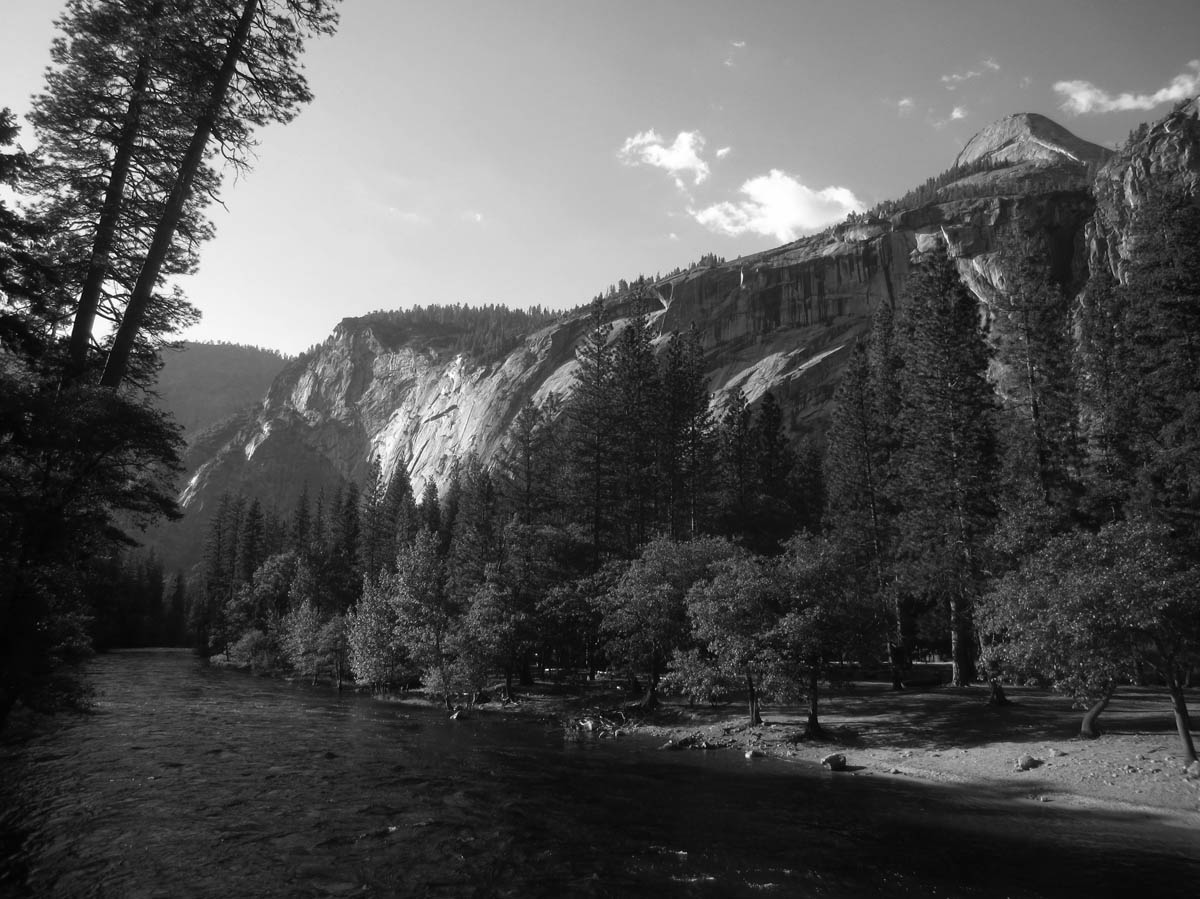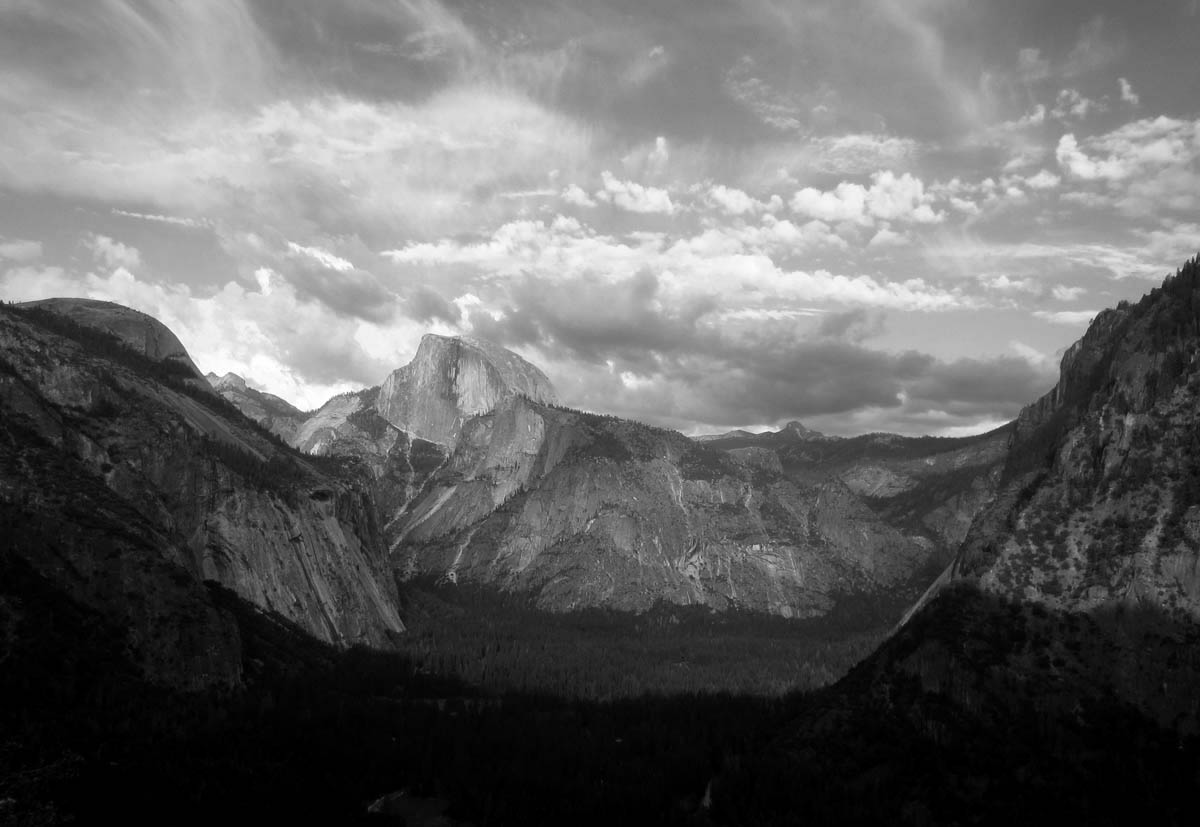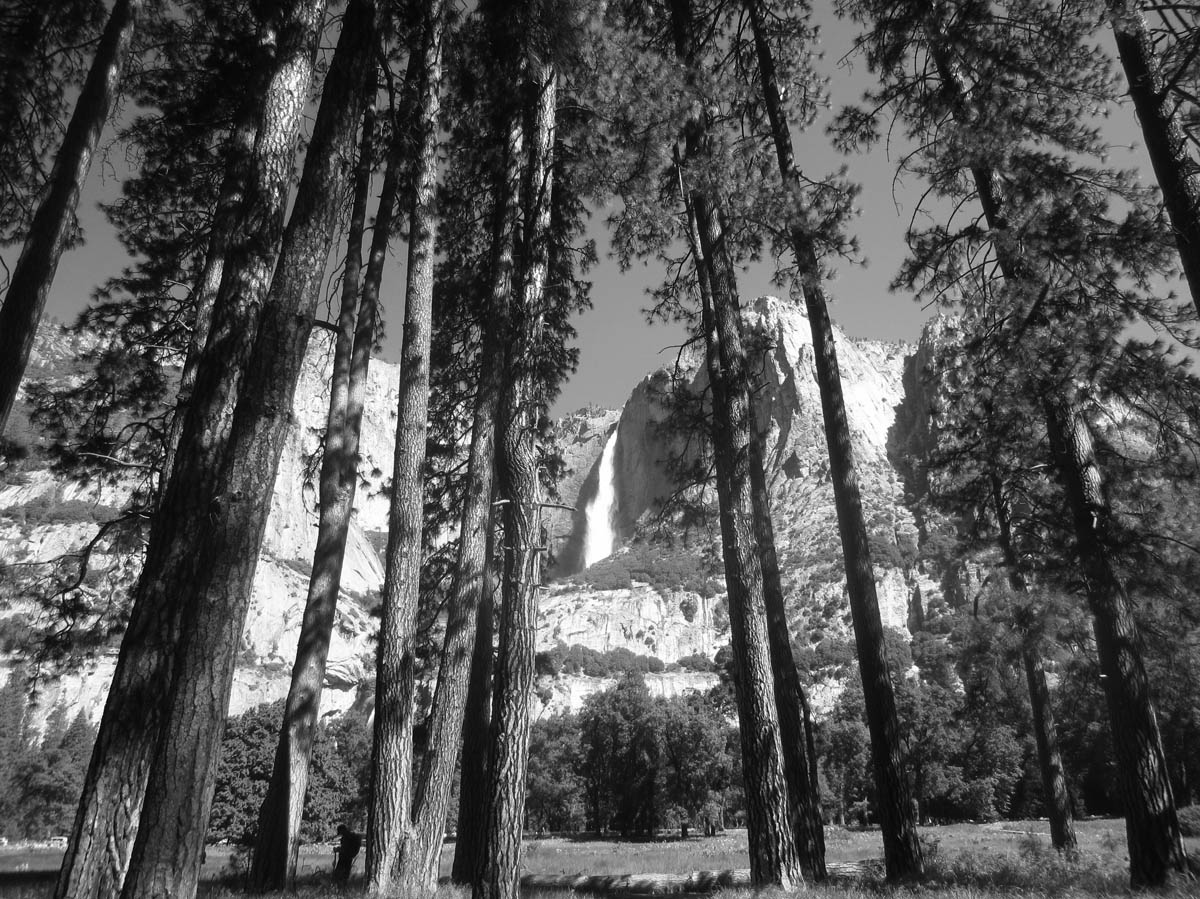As a final look at Yosemite National Park, no blog series would be complete without a tribute to one of it’s biggest advocates and most famous of residents, Ansel Adams. Of course, you know I have to do it, right? The tonality of the sheer granite cliffs is begging for it. The shadows and light demand it. Any self-respecting photography enthusiast has to do it…so forgive me, Ansel, while I play momentarily with your muse of monochrome…
I always attributed Ansel Adams famous grayscale landscapes to that of making an artistic statement. It hadn’t really occurred to me until I considered the timeframe that it was more a matter of medium, as it would be 20 years after his first photographs of Yosemite before color film was even invented. In fact, Ansel Adams did photograph in color, but he didn’t feel he had the same artistic control over color in the darkroom as he did with black and white. He had perfected darkroom techniques such as “dodging and burning” in his black and white work to add definition, texture, and luminosity to his photographs, which earned him the title of “The Poet of the Grayscale.”
Clearly looking into one of Ansel Adams photographs of Yosemite is evocative, as he felt it was important for the “photographs to look like the mountain felt.” His need for “expressing something built up from within rather than extracted from without” is palpable. In reading through some of his quotes, it becomes evident that he was as much about what was happening on his side of the camera as through the lens. I found it no surprise that he was heavily influenced by Ralph Waldo Emerson.
Ansel Adams used his compelling work as an activist for conservation, lobbying Washington for the protection of the “wild.” His book, Sierra Nevada, The John Muir Trail, presented to President Roosevelt was considered instrumental in influencing the President to designate Kings Canyon as a National Park. In turn, the Minarets Wilderness in the Inyo National Forest along with an 11,000+ peak within the wilderness boundaries were named the Ansel Adams Wilderness and Mount Ansel Adams posthumously.
I was also surprised to learn that Adams was an accomplished pianist with the intent to make music his profession. Though mountains won out over music, it was still a prominent part of his life, no doubt crossing over to influence his art as evidenced by his analogy, “The negative is the equivalent of the composer’s score, and the print the performance.”
The Ansel Adams Gallery has a premier presence in Yosemite Valley still today, sitting right in between the Visitors Center and the Wilderness Permit office. It’s the original Best’s Studios, now renamed after the artist, where Ansel met his bride back in the early 20’s.
While in Yosemite, I signed up for a free 90 minute “camera walk” with one of the gallery employees, Julie. She took a group of 15 of us on a stroll across Cook’s Meadow while we talked about Ansel’s life and his work. 
In this meadow, we had an open shot at some of the more iconic areas that he photographed such as Yosemite Falls and Half Dome. Due to the heavy, cumbersome nature of the glass plates that Ansel used, he often had no more than three opportunities at a shot. Julie challenged us to think about the photograph we were about to “make,” and imagine the position and angle we would use should we, too, only have three shots.
Here is my best attempt:
 During this camera walk, I became more aware of light and shadow, intensifying my focus on making that one shot count, considering what I wanted to convey to the viewer. In doing so, I acquired a greater appreciation for Ansel’s focus from both sides of the lens. But I found his words equally inspiring as his photographic work. Here are a few of my favorite quotes:
During this camera walk, I became more aware of light and shadow, intensifying my focus on making that one shot count, considering what I wanted to convey to the viewer. In doing so, I acquired a greater appreciation for Ansel’s focus from both sides of the lens. But I found his words equally inspiring as his photographic work. Here are a few of my favorite quotes:
“There are always two people in every picture: the photographer and the viewer.”
“A good photograph is knowing where to stand.”
“You don’t take a photograph, you make it.”
“A great photograph is one that fully expresses what one feels, in the deepest sense, about what is being photographed.”
“There are no rules for good photographs, there are only good photographs.”
“When words become unclear, I shall focus with photographs. When images become inadequate, I shall be content with silence.”
“Some photographers take reality and impose the domination of their own thought and spirit. Others come before reality more tenderly and a photograph to them is an instrument of love and revelation.”
“No man has the right to dictate what other men should perceive, create or produce, but all should be encouraged to reveal themselves, their perceptions and emotions, and to build confidence in the creative spirit.”








Nicely done, Suzanne.
Ditto!
Thanks for that Suzanne, Ansel would be proud.
It is clear from your photographs that this beautiful place, and others you have visited, stir your soul. We are so fortunate to be able to visit and immerse ourselves in these incredible places.
Yosemite’s dark timber, white granite, and reflecting waters certainly lends itself to Black and Whites. When I’m roaming around in the insane red rock colors in places such as Capitol Reef or Zion, I often wonder if ole’ A. A. would have switched to Kodachrome 🙂
I’ve always thought that Black and White portraits are more “honest” at revealing the “soul” of the subject. But landscapes sometimes demands more…
I do think you embraced your inner Ansel with your B and W photos.
Box Canyon Mark
For several posts in a row now, I’ve been saying “wow.” If I had better command of our language, I might be able to come up with phrases that comprise that “wow.” Today’s post is marvelous. I’m not a photographer, nor a critic. But I have been to Yosemite, and seen some of the views you captured. I think your photos are very nicely done, I like them a LOT. Happy trails!
I love what I call your pensive posts. They are my favorites and adorned with these seriously wonderful shots, they made my day. Did you take all of these beauties on the walk. With an SLR? The shading and reflections are Adams for sure. Love the quotes and the information about him. I knew he was influenced by Emerson, the big man of his day who is one of my favorites. But I didn’t know he was a pianist. Very interesting. Thanks Suzanne this was a wonderful read and view.
Thanks for the nice comment, Sherry. You made my day! I only took two of them on the walk, the one through the trees (Julie said the trees made the falls look bigger, but I don’t see it) and the last photo in the post. The first three were taken on the Mirror Lake Loop Trail. The landscape reflection was taken near Cathedral Rocks, and the close-up of the falls was taken on the Upper Yosemite hike. My Canon S110 has been with Canon Repair for a month now, and they just sent me a G7X as a replacement, because they cannot fix my S110. So all of these were taken with a $99 Canon ELPH. It takes great landscapes, because it has such a wide angle lens. I gave them all the “A.A. Treatment” in post processing.
Hope you and David and Carrie’s family are doing well. One or these days we will meet up and talk about Emerson. 😉
Your “best attempt” is gallery worth… Or at least on one of our walls worth! Not just because you too that shot and in it lies your journey to this point. But more than that I see in it something you “built from within instead of extracting from without”. Therein lies a wonderful lesson in photography… And you got it!
What beautiful work! I am reminded of my own black and white photography days, about 45 years ago! Film (even black and white) was expensive for a kid of 16—but it was exciting when I got a good photo. Thanks for the reminder!
An interesting post, as I started using B & W film and processed and developed my own film and photographs. We were taught the dodging and shading technique when developing but I never realised it came from Ansel Adams. I would spent hours in a darkroom often to emerge with one print. I think that in today’s world of colour photographs it makes us appreciate more the dramatic effect the B & W can have. Cheers.
Curious after reading your book…you mentioned having to get more pages for your passport…how many stamps/pages/books do you have now?
Hi, Debbie — Thank you for supporting the “starving writer” by reading the book! My passport is pretty empty these days, as I don’t do much international travel anymore since retiring, whereas I used to do quite a bit for both business and pleasure. The problem I wrote about in the book is that most African and Middle Eastern countries require a visa, and that often takes one full page of a passport. So one visit to the African continent can fill up a book in a hurry! (It was a nice “problem” to have, though!) Thanks for following the blog and commenting.
I love black and white photography and would have jumped on that camera walk. Your photos are wonderful and that best attempt of yours could be hanging in a gallery right alongside other professionals. I really enjoyed the museum at Yosemite with some of Ansel’s work. I so enjoyed this post and learned a bit more about Ansel Adams, not knowing that he was a pianist. You chose some excellent quotes.
So much fun to see your Black and White photos of Ansel Adams heaven. We not only learned to dodge and burn when I was studying photography, but the Zone System was our bible, with the associated set of gray cards. I had to laugh at Mark’s comment about AA switching to Kodachrome, but I bet not. Another amazing photographer, one I consider the AA of the current day, is Clyde Butcher. Breathtaking stuff. Check him out if you haven’t already. So few large format photographers left out there. Loved reading this, Suzanne.
I love the Ansel Adams quotes. I might use the last one when someone says to me “oh, you’ve photoshopped that”. Photography is an art and we are allowed artistic licence to create whatever we want.
Thank you all for the lovely comments about this post which I enjoyed researching and writing immensely. I am pleased to see that it was of interest. Some of you remarked that you didn’t know Ansel was a pianist. In doing research for the post, I discovered a 90 minute PBS documentary that is well worth a watch. It’s a beautifully moving account of his life with poetic prose, a stirring soundtrack, and stunning scenes from Yosemite and the Sierras. If anyone is interested, here is the link:
https://youtu.be/jvt1ImIKi0U